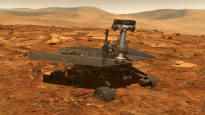In the past, satellite images have captured the logo of the Star Trek series and a character from a children’s program from the surface of Mars.
12:28•Updated 12:28
An incredible image of the surface of the red planet was captured by the NASA satellite imager of the US National Aeronautics and Space Administration.
The round head, two button eyes and muzzle resemble the face of a teddy bear.
In reality, the image taken by the Mars Reconnaissance Orbiter probe shows a circular surface fracture on the surface of the planet Mars. “Teddy’s head” is 200 kilometers in diameter.
The muzzle of the bear in the picture is actually the opening of the volcano.
The picture was taken on December 12, but the University of Arizona, which studies images from the Mars probe, only recently released the picture.
Human imagination plays tricks
Mars with its dust storms, dunes, volcanoes and huge canyons has fascinated mankind for years. Above all, the general public is interested in whether there is life on our neighboring planet.
Scientists have observed various patterns on the surface of the red planet since at least the 1990s. Inaccurate pictures of Mars were already obtained in the 1960s.
Over the years, satellite cameras have recorded numerous images of patterns resembling human faces. The most famous is probably the picture taken by the Viking 1 probe of huge human faces staring into space in 1976.
NASA’s new Mars probe has been taking pictures of the planet since 2006.
In 2019, a Mars probe captured a snapshot of the Starfleet logo from the popular Star Trek series created by wind, lava and dunes.
A year earlier, a satellite imager also recorded a place that looked strangely similar to the face of the character Beaker from the children’s show The Muppet Show.
